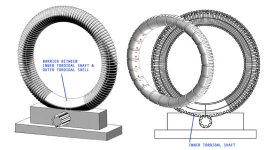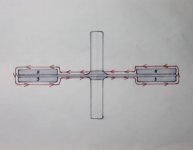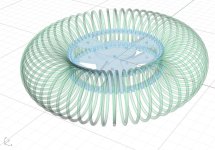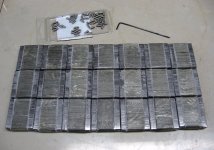APL
100 kW
- Joined
- Aug 6, 2018
- Messages
- 1,113
Things continue to get in the way of progress, but we're still moving forward. Should be able to finish the lam stacks
tomorrow, and move on to the bonding process. I found some polyurethane glue that's fairly thin, and it says that it's
good for steel and glass, so we'll give it a try. The lam's are pretty shinny, and I can't scuff them. I'm hoping this glue's a
little softer than resin, which tends to crack. (Titebond Polyurethane, 20 mnts. work time)
Found some nice little clamps at Walmart, for $2. apiece, that should work well for squeezing them lightly. I am hoping for
some glue insulation between each lam. Back in the old days, they actually used paper in between each one, but that won't
work here. I thought about painting them all first,.. but that will turn it into even a bigger project.
Once they're all bonded, I'll mill a channel on each side to reduce the mass, and give the wire a place to go. I want to keep
the core mass about the same as the Crystalyte has for two teeth, or one complete stator magnet.
After that, they will get some primer, and krypton tape, and be ready for winding. :thumb:
It'll be interesting to see what the total weight turn's out to be.
It will also be nice to get back to machining the rotors, and the other motor parts again.
tomorrow, and move on to the bonding process. I found some polyurethane glue that's fairly thin, and it says that it's
good for steel and glass, so we'll give it a try. The lam's are pretty shinny, and I can't scuff them. I'm hoping this glue's a
little softer than resin, which tends to crack. (Titebond Polyurethane, 20 mnts. work time)
Found some nice little clamps at Walmart, for $2. apiece, that should work well for squeezing them lightly. I am hoping for
some glue insulation between each lam. Back in the old days, they actually used paper in between each one, but that won't
work here. I thought about painting them all first,.. but that will turn it into even a bigger project.
Once they're all bonded, I'll mill a channel on each side to reduce the mass, and give the wire a place to go. I want to keep
the core mass about the same as the Crystalyte has for two teeth, or one complete stator magnet.
After that, they will get some primer, and krypton tape, and be ready for winding. :thumb:
It'll be interesting to see what the total weight turn's out to be.
It will also be nice to get back to machining the rotors, and the other motor parts again.





